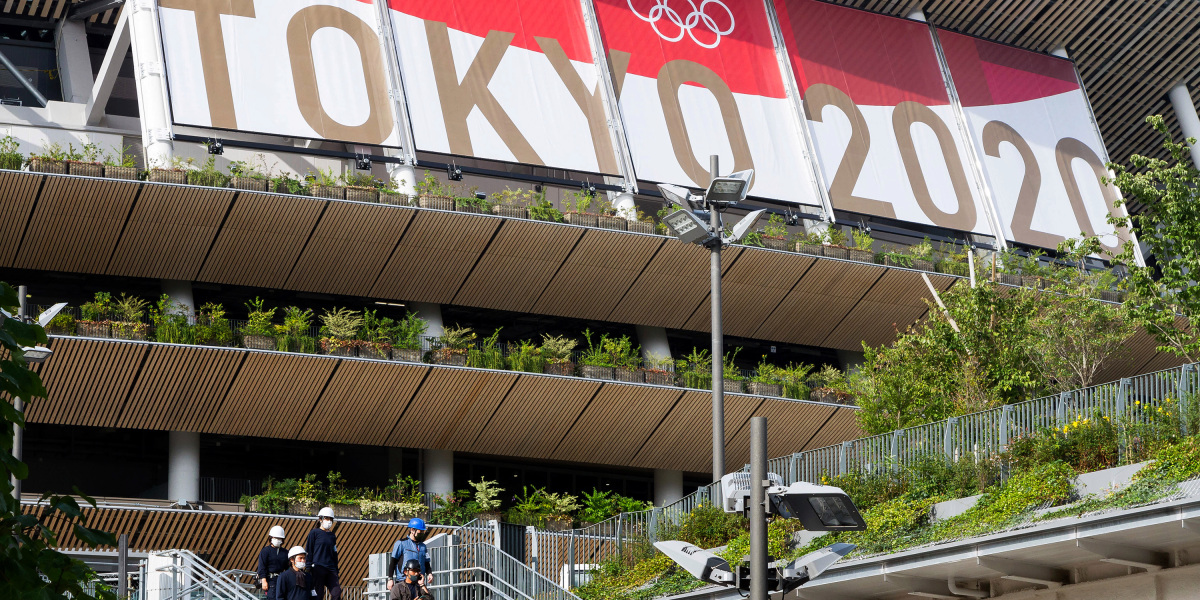
It’s nighttime on the streets of Ibaraki prefecture in Japan when the Olympic torch comes through. A viral video shows the torch bearer’s slow jog past spectators lining the road. Then, as the flame passes, a woman in the crowd shoots a water gun.
“Extinguish the Olympic flame! Oppose the Tokyo Olympics!” she shouts. Security rushes around her.
Such is the backdrop for the upcoming Olympic and Paralympic games, set to begin on July 23 in Tokyo—where covid-19 cases are rising, prompting the city to announce its fourth state of emergency since the start of the pandemic. The rising caseload is especially troubling because the country’s vaccination rate remains low. Just 18% of Japan’s population is fully vaccinated.
Nevertheless the International Olympic Committee is pressing on. At stake are billions of dollars in sunk costs—Tokyo’s Olympic stadium alone cost $1.4 billion—as well as billions more in potential revenue for the IOC, Japan, local organizers, and broadcasters.
A global health crisis that is far from over, a staggering amount of money, and a government set on making its gamble pay off: the forces colliding in Tokyo are unprecedented. And even with strict new rules at the games, experts worry that covid-19 could worsen in Japan.
Keeping athletes safe
Nearly 100,000 athletes, staff and family members, and others are expected to enter Japan for the Olympic and Paralympic games, and organizers say they’re trying their best to keep them safe.
Brian McCloskey, chair of an independent panel advising the IOC on covid-19 mitigation measures for Tokyo, acknowledges the concerns. To reduce the risk of the virus spreading, athletes, staff, and others will be closely monitored, he says.
“The target is not to have no coronavirus in Tokyo,” says McCloskey. “The target is to stop those individual cases becoming clusters and spreading events.”
Athletes, staff, and officials will be tested at various intervals during the games. Residents of the Olympic Village will be tested every day, for example, while the Japanese workers who come in close contact with athletes will be tested more frequently than the people directing traffic. McCloskey says a contact tracing system will be used in the Olympic Village to help contain any cases that emerge. Anyone entering Japan will be required to download a contact tracing app, and athletes and members of the media are asked to turn on GPS tracking on their phones. Organizers say location data will only be used if there are covid cases.
As the games have drawn closer, measures have grown more and more strict. Audience members from other countries were barred months ago, and it was announced earlier this month that there won’t be any audiences at all at venues in and around Tokyo.
“It’s not just the event itself, it’s everything else associated with the event: the hotels, the restaurants, the means of transportation.”
Linsey Marr, professor at Virginia Tech
McCloskey says there is precedent for running the games amid a public health threat—even if earlier ones were not on the same scale as covid. When he advised the IOC for the 2012 London Olympics, organizers considered the potential for a SARS pandemic to emerge, he says. And before the 2016 games in Rio De Janeiro, Brazil, there were concerns about Zika (the WHO later said there were no reported cases in athletes or spectators).
For Tokyo, the IOC has released several “playbooks” of instructions for athletes, staff, volunteers, and press.
But despite stringent rules, the games will inevitably mean people mixing and interacting in ways that otherwise wouldn’t happen.
“It’s not just the event itself,” says Linsey Marr, a professor of civil and environmental engineering at Virginia Tech, who is a leading expert in airborne transmission of viruses. “It’s everything else associated with the event: the hotels, the restaurants, the means of transportation.”






